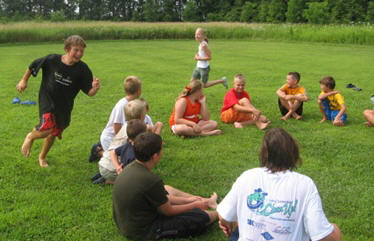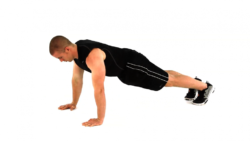Athlete
stands on one leg, with a good posture, with knee of the leg not in contact with
the ground at hips level. Pushing
gently downward on the shoulders of the athlete a few times at the beginning of
the repetition will help the athlete to reach a stable position.
The position of the body can be changed between reps or during a rep as
the athlete become better at maintaining the position.
Should become easy to maintain the position for up to 2 minutes.
Good for: foot, ankle
stability, hip internal rotation, balance.
Duck, duck, goose

A
group of players sit in a circle, facing inward, while another player, who
is "it", walks around tapping or pointing to each player in turn, calling
each a "duck" until finally calling one a "goose".
The "goose" then rises and tries to tag "it",
while "it" tries to return to and sit where the "goose" had been sitting. If
"it" succeeds, the "goose" becomes "it" and the process begins again. If the
"goose" tags "it", the "goose" may return to sit in the previous spot and
"it" resumes the process.
Good for: Ankle stability, high jump, curve running.
(https://en.wikipedia.org/wiki/Duck,_duck,_goose)
Hopscotch and variations
and variations
Use chalk to draw a hopscotch pattern on the ground or use masking tape on a
floor. Create a
diagram with 8 sections and number them. Each player has a marker such as a
stone, beanbag,
bottlecap, shell, button, etc.
The first player stands behind the starting line to toss her or his marker
in square 1. Hop over
square 1 to square 2 and then continue hopping to square 8, turn around, and
hop back again. Pause in square 2 to pick up the marker, hop in square 1,
and out. Then continue by tossing the stone in square 2. All hopping is done
on one foot unless the hopscotch design is such that two squares are
side-by-side. Then two feet can be placed down with one in each square. A
player must always
hop over any square where a maker has been placed.
A player is out if the marker fails to land in the proper square, the hopper
steps on a line, the
hopper looses balance when bending over to pick up the marker and puts a
second hand or foot
down, the hopper goes into a square where a marker is, or if a player puts
two feet down in a
single box. The player puts the marker in the square where he or she will
resume playing on the
next turn, and the next player begins.
The coach can create different patterns demanding to jump on one or 2 feet,
sideways, forward, backward etc. Circles or floot mats can be used to
reset the circuit rapidly.
Good for: Foot, ankle stability, curve running.
Walk on a beam
Athletes are asked to walk on a beam.
Could be an upside down bench. Should be controlled and balanced.
Good for: balance, hip rotation control, foot, ankle stability.
Bear crawl
Begin by getting onto all fours and then rise to your feet
with your hands remaining on the floor. Crawl forward starting with
your right hand and your left foot following with the left hand and the
right foot.
Good for: Ankle mobility, Hip mobility, shoulder strength, pelvis and thorax
stability.
Crab walk
Start in a high plank position, on
hand and feet. Move sideways moving the legs and arms. Coach
should insist on doing the movement right rather than speed of execution.
Maintain a straight back.
Good for: Pelvis and Thorax stability, shoulder strength, hip abduction and
adduction.


 and variations
and variations


